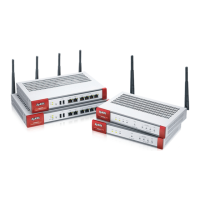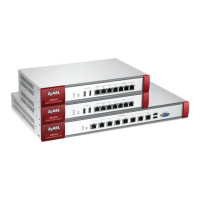Chapter 23 BWM (Bandwidth Management)
ZyWALL ATP Series User’s Guide
435
User Select a user name or user group to which to apply the policy. Use Create new Object if
you need to configure a new user account. Select any to apply the policy for every user.
Schedule Select a schedule that defines when the policy applies or select Create Object to
configure a new one. Otherwise, select none to make the policy always effective.
Incoming Interface Select the source interface of the traffic to which this policy applies.
Outgoing Interface Select the destination interface of the traffic to which this policy applies.
Source Select a source address or address group, including geographic address and FQDN
(group) objects, for whom this policy applies. Use Create new Object if you need to
configure a new one. Select any if the policy is effective for every source.
Destination Select a destination address or address group, including geographic address and FQDN
(group) objects, for whom this policy applies. Use Create new Object if you need to
configure a new one. Select any if the policy is effective for every destination.
DSCP Code Select a DSCP code point value of incoming packets to which this policy
route applies or select User Defined to specify another DSCP code point. The lower the
number the higher the priority with the exception of 0 which is usually given only best-effort
treatment.
any means all DSCP value or no DSCP marker.
default means traffic with a DSCP value of 0. This is usually best effort traffic
The “af” choices stand for Assured Forwarding. The number following the “af” identifies
one of four classes and one of three drop preferences.
User-Defined DSCP
Code
Use this field to specify a custom DSCP code point.
Service Type Select Service Object or Application Object if you want a specific service (defined in a
service object) or application patrol service to which the policy applies.
Service Object This field is available if you selected Service Object as the service type.
Select a service or service group to identify the type of traffic to which this policy applies.
any means all services.
Application Object This field is available if you selected Application Object as the service type.
Select an application patrol service to identify the specific traffic to which this policy
applies.
DSCP Marking Set how the Zyxel Device handles the DSCP value of the incoming and outgoing packets
that match this policy. Inbound refers to the traffic the Zyxel Device sends to a
connection’s initiator. Outbound refers to the traffic the Zyxel Device sends out from a
connection’s initiator.
Select one of the pre-defined DSCP values to apply or select User Defined to specify
another DSCP value. The “af” choices stand for Assured Forwarding. The number following
the “af” identifies one of four classes and one of three drop preferences.
Select preserve to have the Zyxel Device keep the packets’ original DSCP value.
Select default to have the Zyxel Device set the DSCP value of the packets to 0.
Bandwidth Shaping Configure these fields to set the amount of bandwidth the matching traffic can use.
Table 177 Configuration > Bandwidth Management > Add/Edit
LABEL DESCRIPTION

